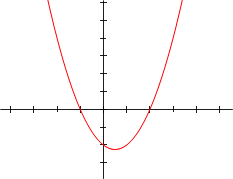
Back Kwadratiese vergelyking Afrikaans Quadratische Gleichung ALS معادلة تربيعية Arabic Ecuación de segundu grau AST Kvadrat tənlik Azerbaijani ایکینجی درجهده موعادیلهلر AZB Квадрат тигеҙләмә Bashkir Квадратнае ўраўненне Byelorussian Квадратнае раўнаньне BE-X-OLD Квадратно уравнение Bulgarian

A quadratic equation is an equation where its highest exponent is 2 (which is why it is called 'quadratic' from the Latin word quadratus 'square'). These equations can be rearranged to the standard form which is[1]ː
where a is not equal to 0, otherwise the equation is linear.
It makes a parabola (a "U" shape) when graphed on a coordinate plane. When people work with quadratic equations, one of the most common things they do is to solve it. This means to find the points on a coordinate grid where the graphed equation crosses the x-axis, or the horizontal axis. These points are called the "zeroes", or "roots", of a function. In other words, to solve the equation means to find the value of x so that , where the coefficients, a, b, and c, are all real numbers. There are different ways to find out the value of x. Plotting the function on a graph is one way. In the picture on the right, the function crosses the x-axis at the points and .
Graphing a quadratic equation makes it is very easy to find the roots, but it is not always convenient. So there are different ways to do this using math.
- ↑ Charles P. McKeague (2014). Intermediate Algebra with Trigonometry (reprinted ed.). Academic Press. p. 219. ISBN 978-1-4832-1875-5. Extract of page 219
© MMXXIII Rich X Search. We shall prevail. All rights reserved. Rich X Search



